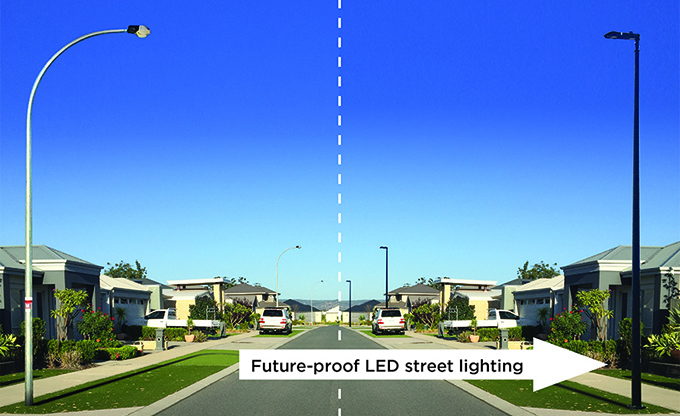Upgrading from Mercury Lamps

Australia’s ratification of the Minamata Agreement will see limitations imposed on the mercury content of different lighting products available for sale. Mercury vapour (MV) lamps are used in approximately 39% of street lighting poles in Australia and are also prevalent in commercial applications in high bay luminaires. A simple like-for-like replacement will not be possible after manufacturers in Asia and Europe cease production in 2020, leaving consumers facing the decision to replace MV lamps with either an LED Chip-on-board (COB) lamp OR to replace the entire luminaire.
The issues that need to be considered are:
- Heat Management
Ensuring LED chips remain cool while in use is of paramount importance to ensure minimal energy usage and lifetime of the light source. LED Luminaires are able to utilise different mechanisms throughout the complete product to ensure that heat is managed appropriately, while LED COB lamps are not able to dissipate heat in the same way. In applications such as enclosed street lights, the sealed environment restricts airflow, in turn heating the LED chips and reducing the lifetime of the lamp and decreasing light output. Some new products have enclosed fans within COB lamps to help facilitate airflow. Some products are designed to be used in applications where the lamp is exposed outside of the luminaire while others are designed for enclosures. If a COB lamp is to be used, ensure that it is fit for purpose.
- Installation
When comparing the two technologies, there are some hidden costs associated with a simple upgrade from MV to LED COB lamps. On top of the common steps of deenergising and access, MV lamps require a ballast which protects the lamp from overdrawing current. As these are not required by LED COB lamps which include controlgear within the device, MV luminaires larger than 100 W will require the electrical ballast to be bypassed by an electrical contractor adding time and cost to installation, otherwise an additional 15 to 20 W of power may be required.
- Weight
LED COB lamps weigh considerably more than the equivalent MV lamp. As such, there have been cases of LED COB lamps falling out of lampholders due to age and lack of integrity. This poses significant risk in the main applications of these replacements, being highbays and street lighting. Some larger LED COB lamps are now sold with a lanyard which is attached to the fitting during installation. This lanyard mitigates risk but adds time to installation and presents another dimension to maintenance.
- Controls
The installation of new luminaires provides an opportunity for the inclusion of smart controls to be integrated into light fittings. Digital dimming controls are standard in quality highbay products while street lighting products can include a range of different sensors and controls as well as communications devices and expansion opportunities.
- Heritage Luminaires
In some retrofit activities, it may be a requirement to preserve heritage luminaires or offer a replacement with a similar design. Due to the cost of producing a new custom luminaire, it may be more economic to simply replace a MV lamp with an LED COB lamp.
- Maintenance
In the context of street lighting, the Institute of Public Works Engineering found that the maintenance costs of a LED luminaire were approximately 50% of existing MV installations. When ballasts are not removed during retrofit activities, these parts or other sections of the luminaire will often fail before the lamp, prematurely adding additional costs to maintenance activities after installation.
- Optics
Luminaires are designed to distribute light for particular lamp technology. Lamps with different photometric properties will change the distribution of light and without consideration, COB Lamp retrofits could render installations non-compliant with Australian standards.
In making decisions regarding upgrading MV luminaires, it is important to consider hidden costs associated with a simple lamp-for-lamp replacement. Procurement must ensure that product operating conditions, installation costs, safety, future compatibility and maintenance are contemplated to ensure economic, quality lighting outcomes.
*Text from Lighting Council Australia
